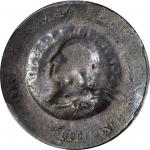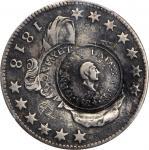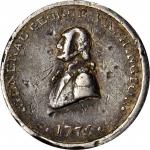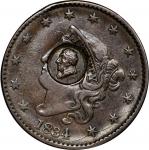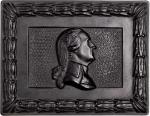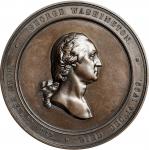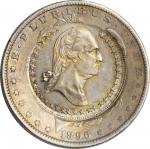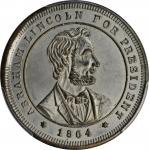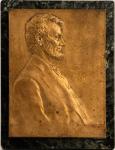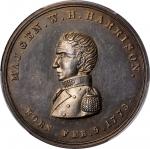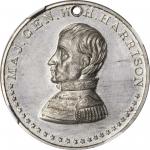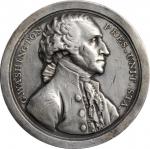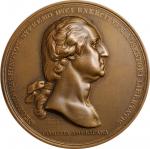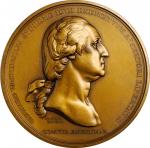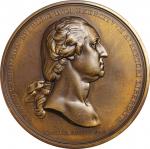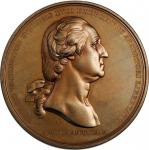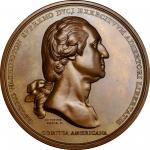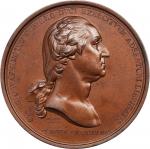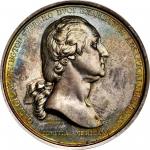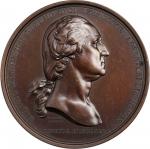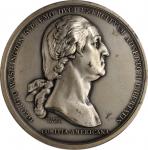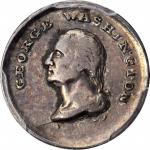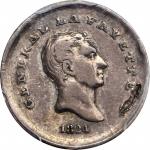1824 Lafayette Visit medalet. Silver. 15 mm. Musante GW-112, Baker-198A. VF Details—Damage (PCGS).A gouge just after the word LAFAYETTE and a couple of ancient scratches account for the PCGS designation, but overall this piece has nice eye appeal otherwise. Lovely light silver gray with blue and violet highlights in the fields. The original integral hanger is lost, as is the case on most of these we see. Rare and a Washington classic, necessary for any important collection of this series. Long thought to the be the work of C.C. Wright, but shown in 1999 by John Kleeberg to be from dies by Joseph Lewis. Produced as a celebratory memento marking Lafayettes famous 1824 return visit to the United States, and thus particularly historic. <p>In 1824 the Marquis de Lafayette, French hero of the American Revolution, revisited America and was proclaimed by Congress to be "The Nations Guest." Numerous printed, medallic, and other tributes were created during the course of his stay in the United States, which extended into the year 1825.<p>James Hardie, A.M., in The Description of the City of New York, printed and published by Samuel Marks, New York, 1827, told of the memorable occasion:<p><em>"I now come to an event which will long be remembered with pleasure by the inhabitants of this metropolis. On Sunday 15th August, General LaFayette, who had for some time been anxiously looked for, arrived at Staten Island, where he remained at the mansion of his excellency the late Daniel D. Tompkins, then vice president of the United Sates, till the day following, when he made his public entrance into this city. </em><p><p><em>"To this illustrious man, the United States are more indebted for that liberty and independence which they now enjoy, than to any individual now living. His gratuitous and highly important services as a Major General in our army, his unceasing exertions to procure aid from France, and his repeated and very liberal supplies of money for the use of our half naked and suffering soldiers, during the Revolutionary War, were still fresh in the minds of our fellow citizens. Hence he was treated with a most cordial welcome-a degree of rapture almost bordering on enthusiasm.</em><p><p><em>"He landed at Castle Garden amidst the acclamations of many thousands, the ringing of bells, and the firing of cannons. All the merchant and coasting vessels in our harbour hoisted their colors, and the ships of war, packets and numerous steam boats, were decorated with flags of different nations in the most elegant manner. In short, no demonstration of joy, which the ingenuity of our citizens could invent, was wanting to express the pleasure which was so generally felt on the arrival of this veteran hero, this distinguished Guest of the Nation, at our metropolis. </em><p><p><em>"After tarrying a short time at Castle Garden, he was escorted to the City Hall, where he was received in form by the Common Council, and addressed in a very appropriate speech by the Hon. Wm. Paulding, Junr., then mayor, to which he made an affectionate and very suitable reply. </em><p><p><em>"From thence he was conducted to the lodgings, previously provided for him, by the Common Council, at Mr. Bunkers splendid hotel in Broadway. During his short residence amongst us, he visited our navy yard and garrisons, our public institutions, theatres, &c., and was every where received with that gratitude, to which, from his eminent services, he was so justly entitled. He daily kept a levee, at certain hours, in the City Hall, where he was incessantly visited by crowds of citizens, with whom he conversed with great familiarity, and readily shook hands with everyone, who came forward for that purpose. </em><p><em>"The time of his departure having arrived, he was escorted by a numerous detachment of artillery, infantry, and cavalry, to Kingsbridge, where they took an affectionate leave of their noble and amiable friend. Although, when he landed at this port, he was in the 68th year of his age, and walked lame in consequence of his wound, he, in the space of thirteen months, visited most of the principal places in the United States, from North to South, and from East to West; and so ardent was his desire to behold the vast improvements, which, since his last visit, had taken place in every part of our country, that it is highly probable he traveled with more dispatch and made greater progress than had ever been done in the United States by any one, whether young or old.</em><p> <p><em>"On the 13th day of September, after taking an affectionate leave of the President, and heads of department, he proceeded to the frigate Brandywine, Commodore Morris, which had been fitted up for his accommodation, and in which he landed at Havre in November following."</em><p><p>Among the more interesting numismatic items associated with this event are the aforementioned Lafayette-Washington counterstamps made from the dies of a 9 mm. medalet impressed on the obverse and reverse of contemporary circulating coins. The obverse (usually) is inscribed GENERAL LAFAYETTE, with the date 1824 below, surrounding a portrait of Lafayette facing right. The reverse die has the inscription GEORGE WASHINGTON in a partial circle surrounding a portrait of Washington facing left.<p>Most examples of counterstamped cents seen by Dave Bowers in his extensive studies of these pieces have Washington on the obverse of the host coin and Lafayette on the reverse, although, as it will be seen, this is more a "Lafayette" item than a "Washington" item-if priorities were assigned. It seems to Dave that while Lafayette was the preferred obverse, there was no hard and fast rule at the time these were made. After the EB counterstamp on 1787 gold doubloons and the CAL counterstamp on 1848 quarter eagles, the Washington / Lafayette counterstamp is the most famous in American numismatics.<p><p>From the Q. David Bowers Collection. Earlier ex F.C.C. Boyd; John J. Ford, Jr., purchased directly from John. J. Ford in March 1985.




